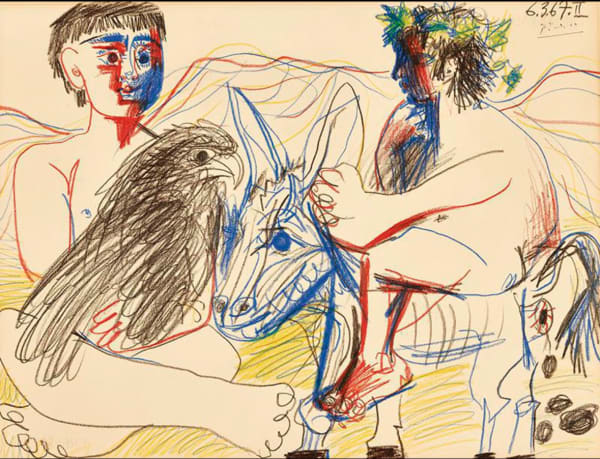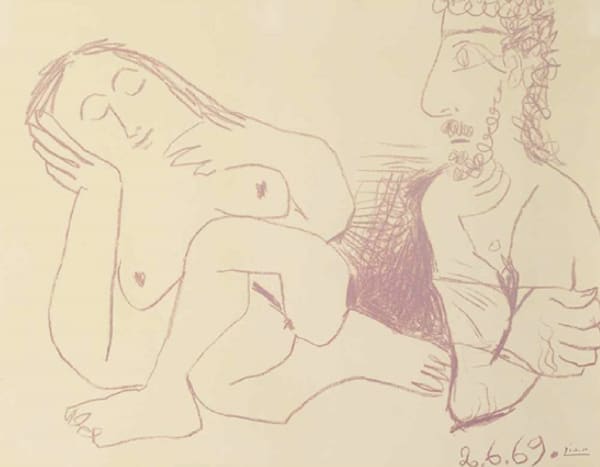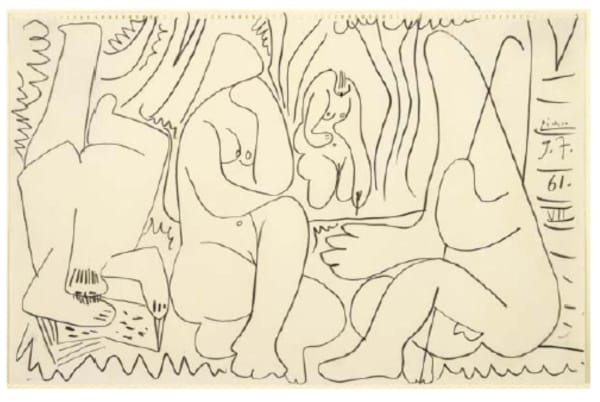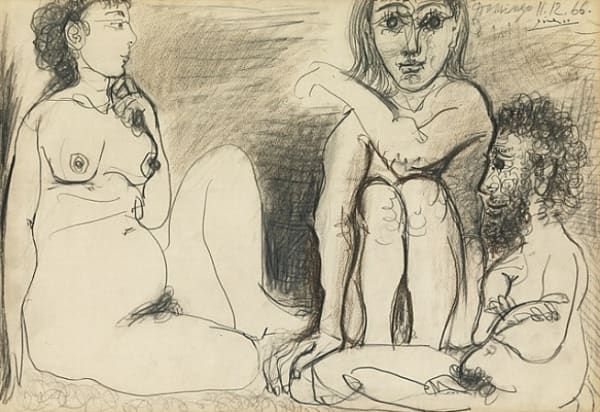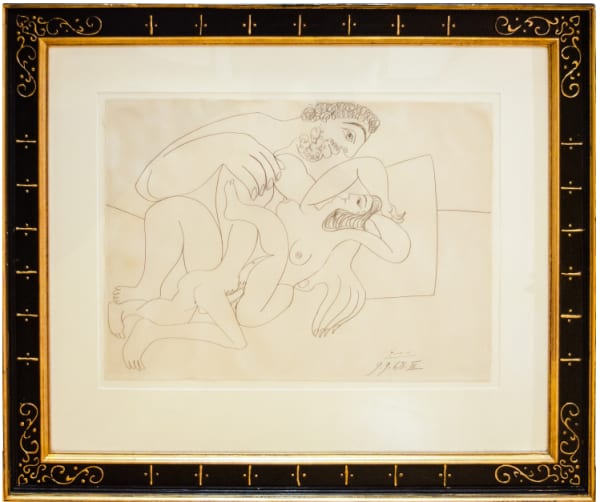
Pablo Picasso
Signed and dated
33 x 42 cm
This drawing, titled Étude pour la Suite des Déjeuners III, dated 10 August 1959 and signed by Pablo Picasso, is a masterful example of his late-period line drawings. Rendered in sparse yet fluid graphite or ink, the sketch exemplifies Picasso’s remarkable ability to distill complex scenes into pure, continuous line, capturing both narrative and emotion with minimalist clarity. This study is part of a series of preparatory drawings that reimagine Le Déjeuner sur l’herbe, the controversial 1863 painting by Édouard Manet, itself a modern reinterpretation of earlier pastoral themes in European art.
Picasso’s use of unbroken, lyrical lines demonstrates his deep command of gesture and form. Despite the apparent simplicity, every stroke is deliberate, suggesting bodily movement, intimacy, and psychological interaction. The figures appear to merge and morph, their contours flowing into one another, creating a dreamlike, almost surreal composition. What might at first seem chaotic resolves into a coherent arrangement of reclining and seated forms, interspersed with vegetal motifs—trees, clouds, and foliage—rendered in stylized curvilinear forms.
The sketch employs a rhythmic visual language: the repetition of rounded shapes for heads and breasts, the articulation of bent limbs, and the compression of spatial depth all serve to flatten the composition. This recalls both Cubism and the classical frieze structure, showing Picasso’s simultaneous command of modern and ancient visual idioms.
What makes this drawing especially compelling is the way it balances sensuality with abstraction. Nudity, eroticism, and playfulness are evident in the depiction of lounging bodies and ambiguous gestures, yet the forms resist being overly explicit or literal. This tension between figuration and abstraction is a hallmark of Picasso’s late style.
This sketch serves as a preparatory study—or étude—for a larger and more fully realized composition. Picasso was known for working extensively through serial explorations, often creating dozens of drawings and variations before committing to a final painting, sculpture, or print. These studies allowed him to experiment freely with composition, line, emotion, and symbolism.
In the case of Suite des Déjeuners, Picasso was revisiting one of the great motifs in the history of modern painting. He did not aim to replicate Manet’s work, but to interrogate and transform it through his own lens. The process of sketching allowed Picasso to dismantle traditional forms and reconstruct them in a radically personal style—more erotic, more fragmented, more psychological.
By stripping away detail and working solely in line, Picasso could quickly iterate and refine the essential structure of the scene. These studies helped him explore alternative arrangements of bodies, postures, and spatial relationships. Notably, the act of drawing was not merely preparatory—it was an essential part of Picasso’s creative thinking, a way of entering into dialogue with both his subject and the history of art.
This drawing exemplifies Picasso’s ability to use line not only as a visual tool but as a philosophical and historical one. It reveals the artist in his element: experimental, reflective, and deeply connected to both the past and the present. For more information on
Étude pour la Suite des Déjeuners III for sale, contact our galleries via the inquiry form below.-
 Pablo PicassoThe Foot Bath | Le Bain de pieds, 1960
Pablo PicassoThe Foot Bath | Le Bain de pieds, 1960 -
 Pablo PicassoFemme tenant un journal, 1915
Pablo PicassoFemme tenant un journal, 1915 -
 Pablo PicassoTrois Personnages,, 1954
Pablo PicassoTrois Personnages,, 1954 -
 Pablo PicassoQuatre têtes d’élégantes (Four Elegant Heads), c. 1899
Pablo PicassoQuatre têtes d’élégantes (Four Elegant Heads), c. 1899 -
 Pablo PicassoLes déjeuners,, 1961
Pablo PicassoLes déjeuners,, 1961 -
 Pablo PicassoTête de faune, 1958
Pablo PicassoTête de faune, 1958 -
 Pablo PicassoTeenager, eagle and donkey, 1967
Pablo PicassoTeenager, eagle and donkey, 1967 -
 Pablo PicassoTrois hommes et femme nus, 1967
Pablo PicassoTrois hommes et femme nus, 1967 -
 Pablo PicassoHomme Assis, 1971
Pablo PicassoHomme Assis, 1971 -
 Pablo PicassoBust of Naked Man and Woman, 1969
Pablo PicassoBust of Naked Man and Woman, 1969 -
 Pablo PicassoLe déjeuner, 1962
Pablo PicassoLe déjeuner, 1962 -
 Pablo PicassoLes déjeuners,, 1961
Pablo PicassoLes déjeuners,, 1961 -
 Pablo Picasso·Toros, 1961
Pablo Picasso·Toros, 1961 -
 Pablo PicassoLes Dejeuners, 1961
Pablo PicassoLes Dejeuners, 1961 -
 Pablo PicassoTrois Personnages nus Assis, 1966
Pablo PicassoTrois Personnages nus Assis, 1966 -
 Pablo PicassoHomme et Femme, 1926
Pablo PicassoHomme et Femme, 1926 -
 Pablo PicassoL’Etreinte, 1968
Pablo PicassoL’Etreinte, 1968
Join our mailing list
* denotes required fields
We will process the personal data you have supplied in accordance with our privacy policy (available on request). You can unsubscribe or change your preferences at any time by clicking the link in our emails.
This website uses cookies
This site uses cookies to help make it more useful to you. Find out more about cookies.






